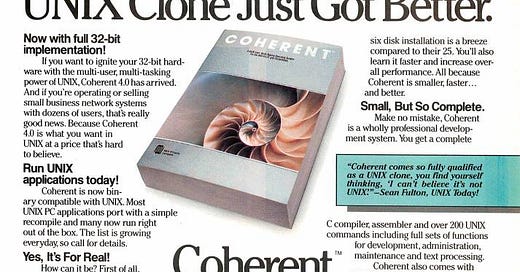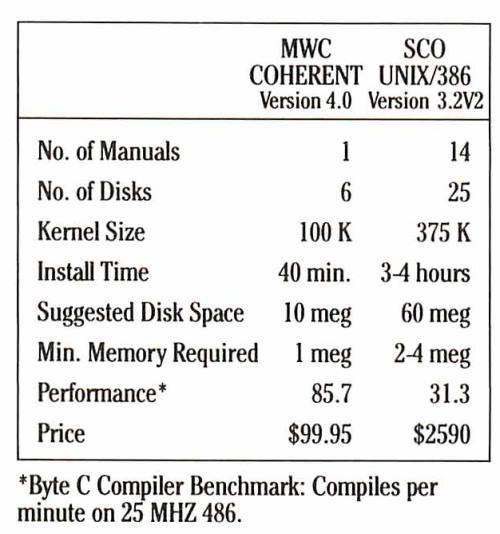Last week, we covered a version of UNIX. This week we are looking at something different yet similar. You’ll understand when you start reading.
Before we begin, I’d like to thank Paolo Amoroso for suggesting this topic. It’s been very fun to research.
In 1977, Robert Swartz took over the Mark Williams Company from his father. The company got its name from Swartz’s father, William Mark Swartz. (William Swartz had created a soft drink in the 1940s named Dr. Enuf. Dr. Enuf can still be found in parts of Tennessee, Virginia, and North Carolina. Interestingly, John Scully, former CEO of Apple, was working at Pepsi when Steve Jobs convinced him to join Apple. Steve Jobs reportedly said, “Do you want to come with me and change the world, or do you want to sell sugar water for the rest of your life?”)
The first product released by the Mark Williams Company was XYBASIC in 1977. Swartz wanted a BASIC to compete with Microsoft’s BASIC. XYBASIC had some advanced features that set it apart from other versions of BASIC, such as support for process control for more industrial work.
A Clone is Born
Moving to something more advanced, Swartz saw a need for a cheaper clone of UNIX for personal computers. At the time, a license for AT&T UNIX was very expensive. In fact, in May 1975, a company would have to pay $200,000 for a license. (An educational institution could get one for $200.) A small company like Mark Williams could not afford it, so it was decided to clone Unix.
The idea was to create an operating system that looked and acted like UNIX. It needed to run software created for UNIX. It would be written completely from scratch so that AT&T could not have any claim to it. In technical terms, they needed to reverse engineer UNIX.
Below is a clip from Triumph of the Nerds, where Robert X. Cringely explains how Compaq reverse-engineered the IBM PC. You can also view the clip on Odysee. I recommend the full miniseries for anyone interested in the history of the PC.
The Mark Williams team didn’t exactly follow these meticulous steps. At the time, many programmers had been exposed to the source code of UNIX while at college, so it would have been hard to find programmers who were clean or virgins. One Mark Williams employee named Tom Duff related that while he was working on Coherent, he opened up the UNIX 6th edition manual and started implementing commands. According to him, in the three months he was at the company, he went from A to M.
By 1980, Coherent was available for the PDP-11, which is what it was written on. Since it was written in C and designed from the ground up to be very portable (a luxury that UNIX didn’t have early on), it was quickly ported to other systems. The first is the IBM PC.
Initially, Coherent was only sold to computer manufacturers to be sold with their systems. But that changed in 1983, when Coherent when public. The first public release of Coherent was for the IBM AT.
Here is a quote from an article in the June 1984 issue of PC Magazine entitled “A Good Buy on UNIX.”
“The Mark William’s COHERENT operating system is a state-of-the-art microcomputer implimentation of AT&T’s UNIX, without the state-of-the-art AT&T licensing fees. It is a completely rewritten version of the seventh edition of UNIX and includes some of its multi-user and multitasking abilities…It currently runs on PDP-11, 8086, 8088, 68000, and Z-800s-based systems.
Those who already have a stockpile of UNIX applications ready to compile and go are in good shape with COHERENT, However, for the rest of us, the question of how much application software is avialble arises. MS-DOS wasn’t much of a show-off to the neighbors, after all, before the advent of (Lotus) 1-2-3 and The Curse of Ra. The Mark Williams people claim that within 6 months the company will have optional spreadsheet, database management, and conventional word processing package available. And, of course, COHERENT is by definition an ideal tool for system application developers who are targeting their software for the burgeoning UNIX-compatible market.
…
Many people who want a UNIX-like oeprating system are probably feeling cautious right now and waiting for the market to shake out. All I can say is that COHERENET, at $500, is the kind of bargin that is not likely to be around forever. As planned improvments are added, this price is bound to rise commensurately. Furthermore, if you are a registered user, when new versions are released you can get a new copy with updated documentation for only $50, less then what Ashton-Tate charges for replacing a few bugs in dBASE II.
Later on, the price of Coherent was lowered to less than $100. It must have been an attempt to make it more interesting for home users. The April 1990 issue of InfoWorld stated, “Coherent is a no-royalty clone of Unix in a smaller package — one manual and five disks — that is sold directly so PC owners can experiment with it for less than $100.”
AT&T Comes Knocking
AT&T was worried that Mark William was stealing their code. After all, this little company with suddenly selling a UNIX-compatible operating system, and they didn’t have a UNIX license. AT&T decided to send some people including Dennis Ritchie, one of the original creators of UNIX, to check out Coherent.
Here is what Ritchie had to say about that encounter in 1998:
An anecdote: sometime fairly early after the Mark Williams company started offering their Coherent system (a Unix clone), some AT&T legal people asked me to visit Mark Williams for purposes of determining whether what they were offering was a rip-off (i.e. essentially a copy) of the currently licensed Unix done by us. I find it hard to reconstruct the date this happened, but it was a long time ago; probably early 1980s. I went to Chicago with Otis Wilson, who was then involved in Unix licensing. It was a rather strange experience. The Mark Williams company was a paint producer, and I was given to understand that the subsidiary that was doing Coherent was, approximately, a corporation arranged by a father who, approaching retirement, had more or less shut down the older business and was using the corporate name and legal setup to help his son in a new venture.
Otis and I visited the offices of Mark Williams on the outskirts of Chicago and were received with courtesy and some deference. We talked to the father and the son (Bob Swartz, i.e. the guy behind Coherent). There had been communication before, and from their point of view we were like the IRS auditors coming in. From my point of view, I felt the same, except that playing that role was a new, and not particularly welcome, experience. The locale of the company was in an industrial section and it definitely retained the flavor of a the offices of a paint company being recycled.
What I actually did was to play around with Coherent and look for peculiarities, bugs, etc. that I knew about in the Unix distributions of the time. Whatever legal stuff had been talked about in the letters between MWC and AT&T didn't allow us to look at their source. I'd made some notes about things to look for.
I concluded two things:
First, that it was very hard to believe that Coherent and its basic applications were not created without considerable study of the OS code and details of its applications.
Second, that looking at various corners convinced me that I couldn't find anything that was copied. It might have been that some parts were written with our source nearby, but at least the effort had been made to rewrite. If it came to it, I could never honestly testify that my opinion was that what they generated was irreproducible from the manual.
I wrote up a detailed description of this. I can't find it, probably because at the time I was advised that it was privileged lawyer/client material. Partly at the time, partly thereafter, I learned that a variety of Unix enthusiasts (several from U. Toronto) had spent time there.
In the event, "we" (=AT&T) backed off, possibly after other thinking and investigation that I'd wasn't involved in.
So far as I know, after that MWC and Coherent were free to offer their system and allow it to succeed or fail in the market.
This kind of reminds me of a similar situation between CP/M and MS-DOS. MS-DOS was originally named QDOS (Quick and Dirty Operating System) and was created by Tim Paterson. Gary Kildall, the creator of CP/M, claimed that MS-DOS was so close to a copy of his work that it shared the same errors and bugs.
Legacy
In the end, Coherent was not the huge moneymaker its creators thought it would be. It didn’t get much traction and was overshadowed by products from much larger companies, not to mention the growth of Linux.
Mark Williams shut down in 1995. Ten years later, the code for Coherent was open-source. You can find it here. If you would like to find out more information about Coherent, check out this episode of Advent of Computing.
What computer ads would you like to see in the future? Please comment below. If you enjoyed it, please share it with your friends and relatives. Thank you.








Seeing stuff like this makes me think about "what could have been" had market conditions been even slightly different at the time.
Thanks you very much, very informative.